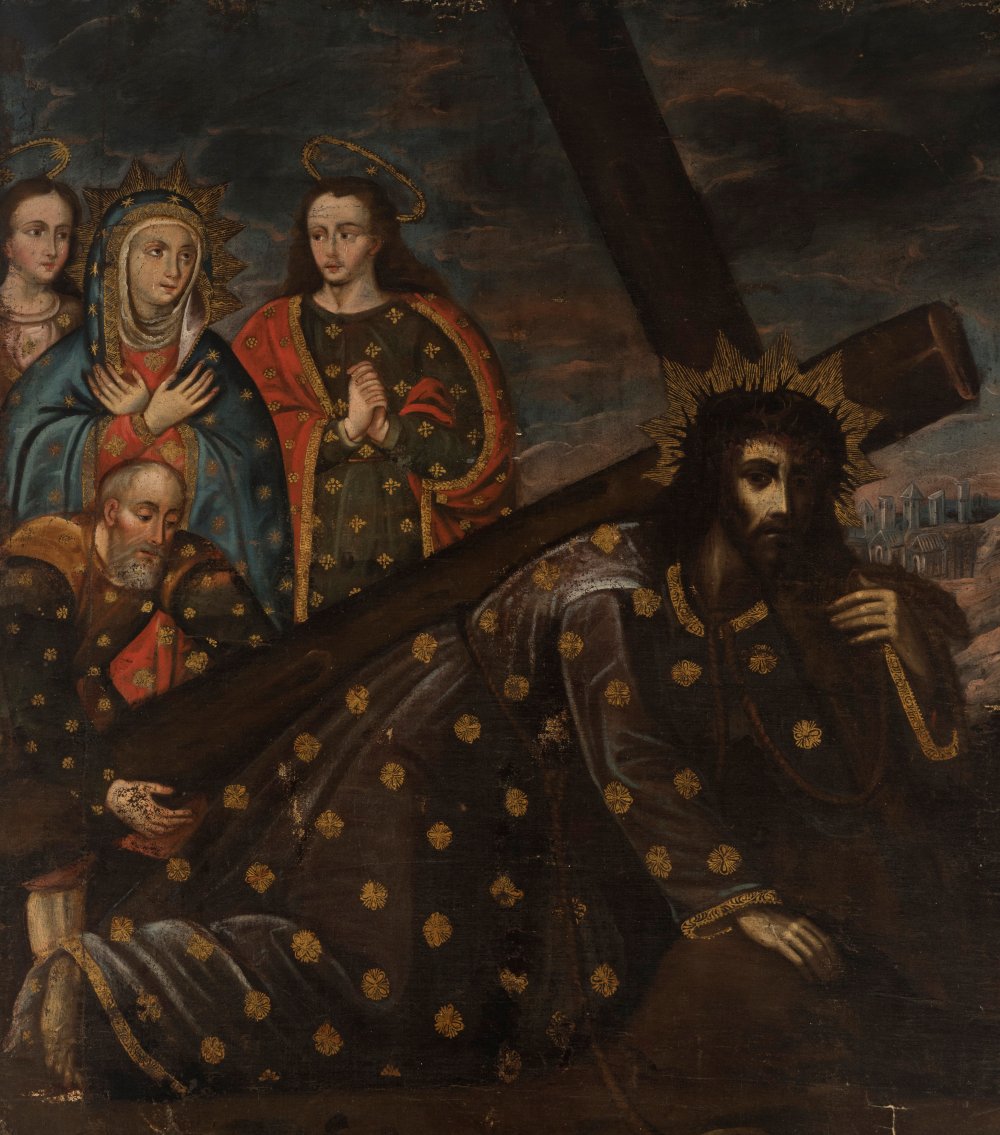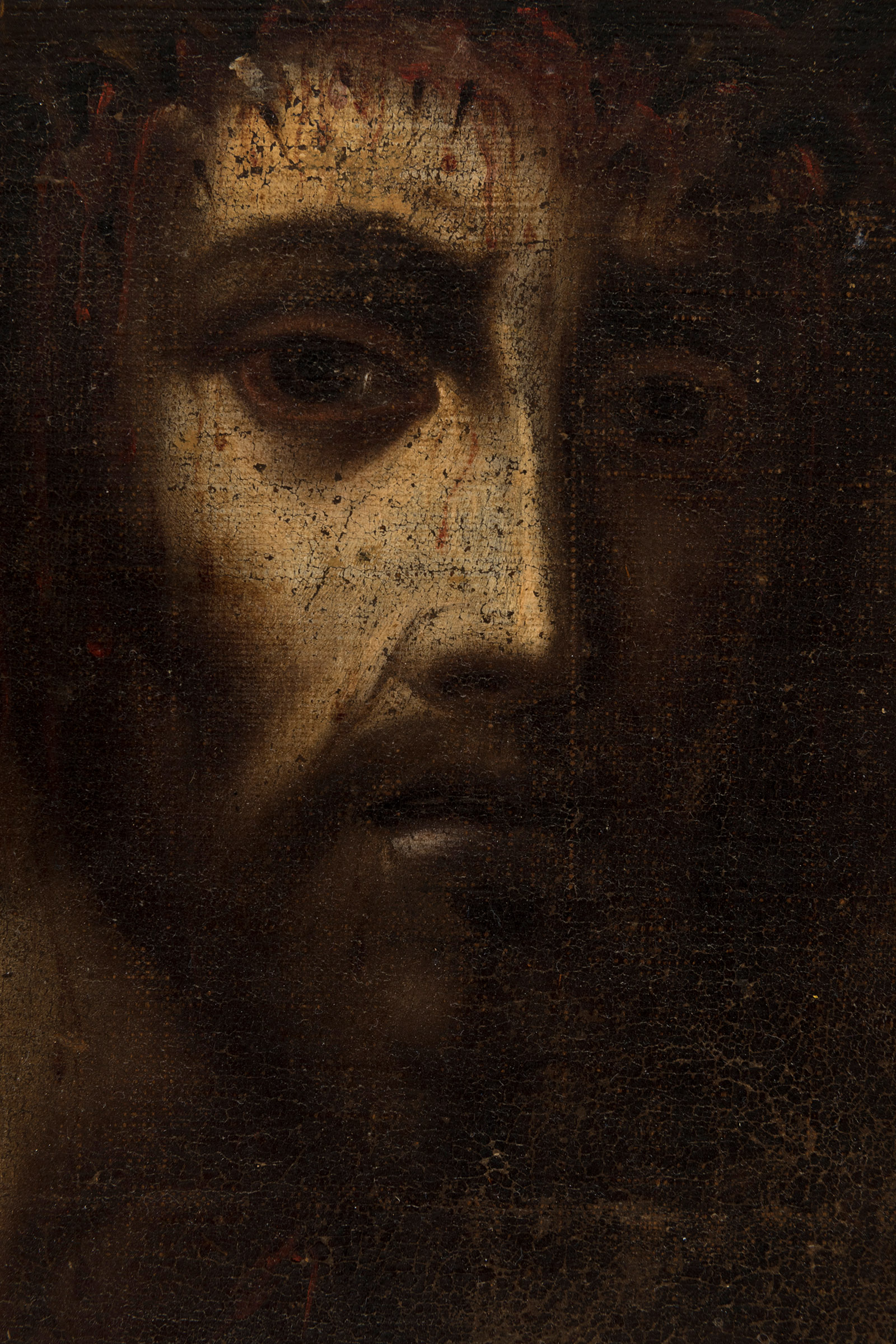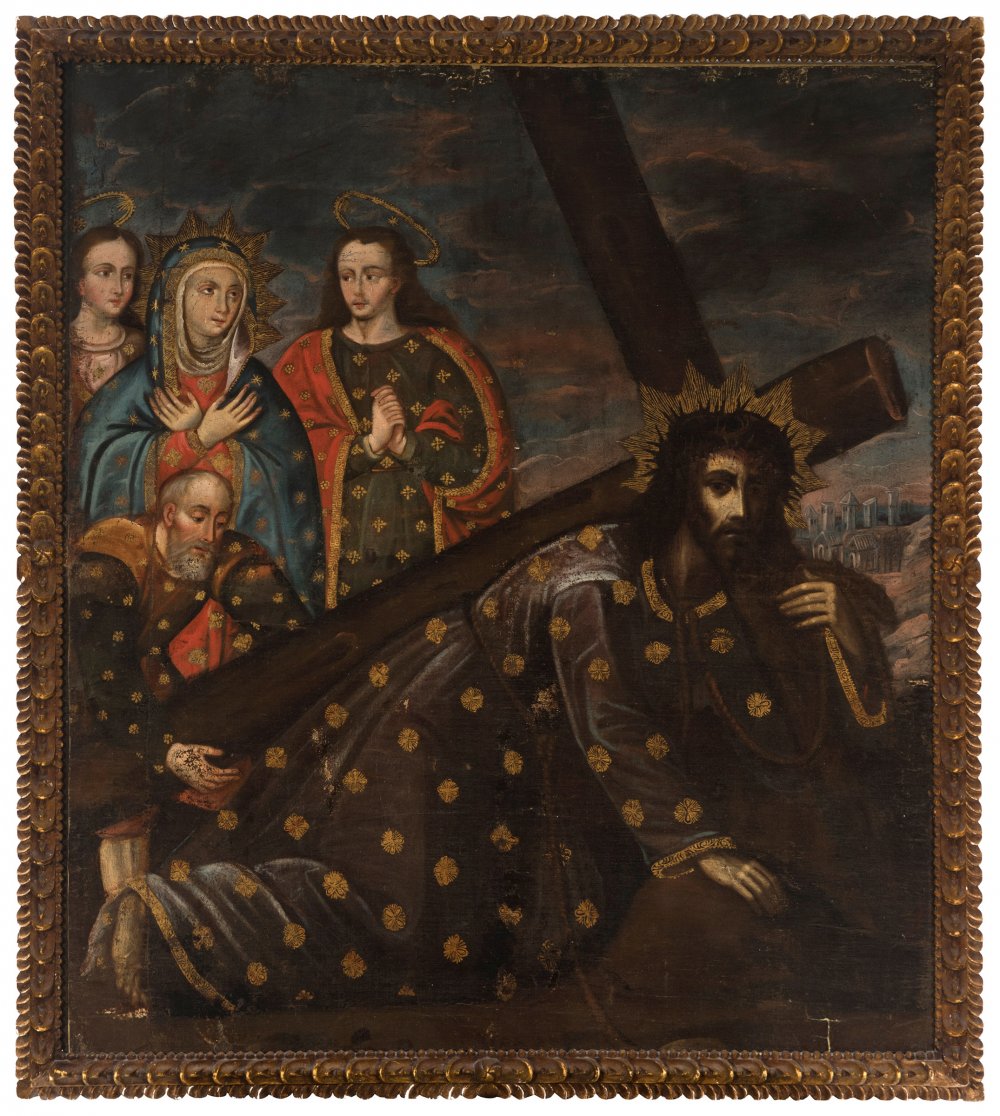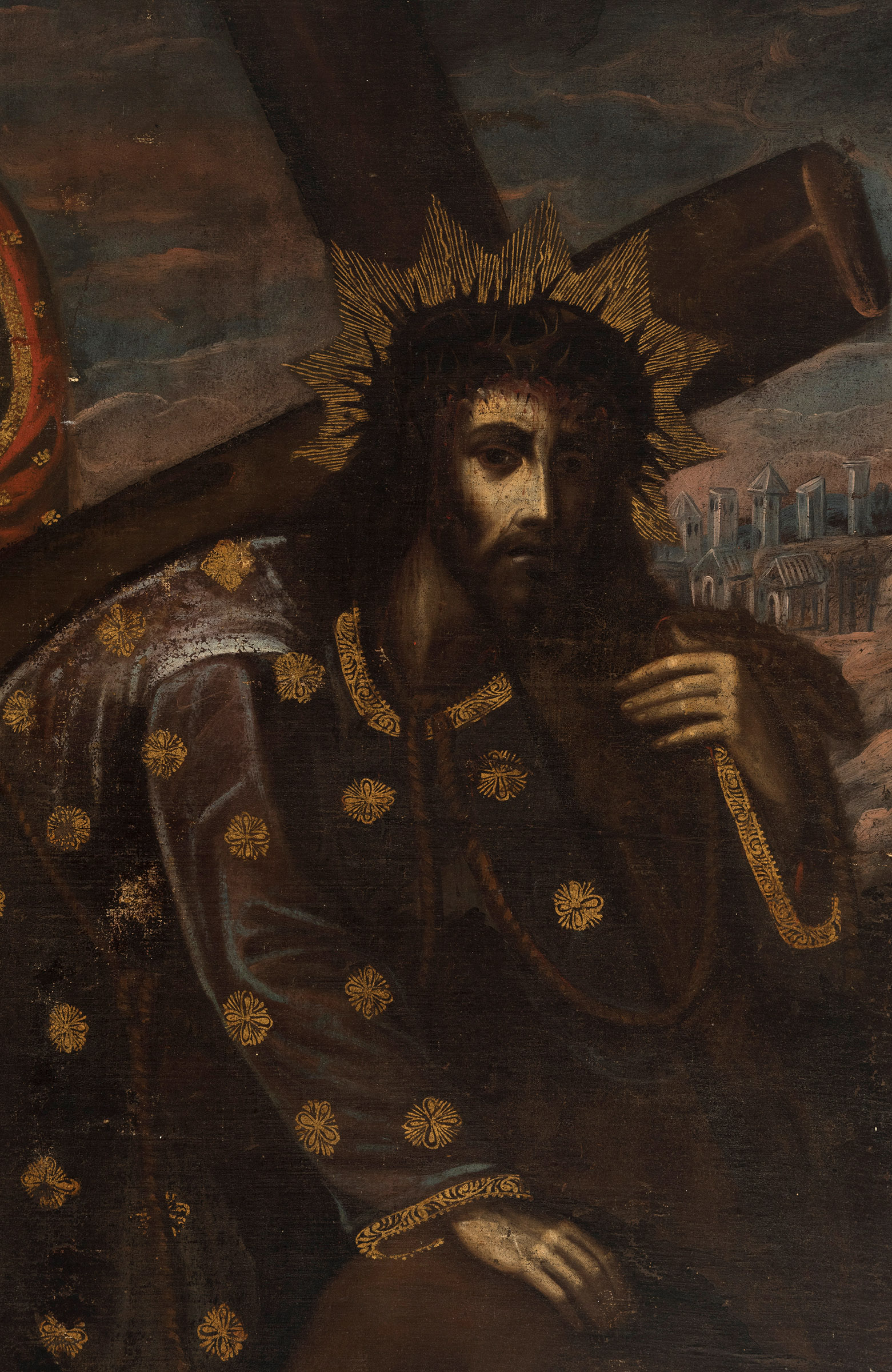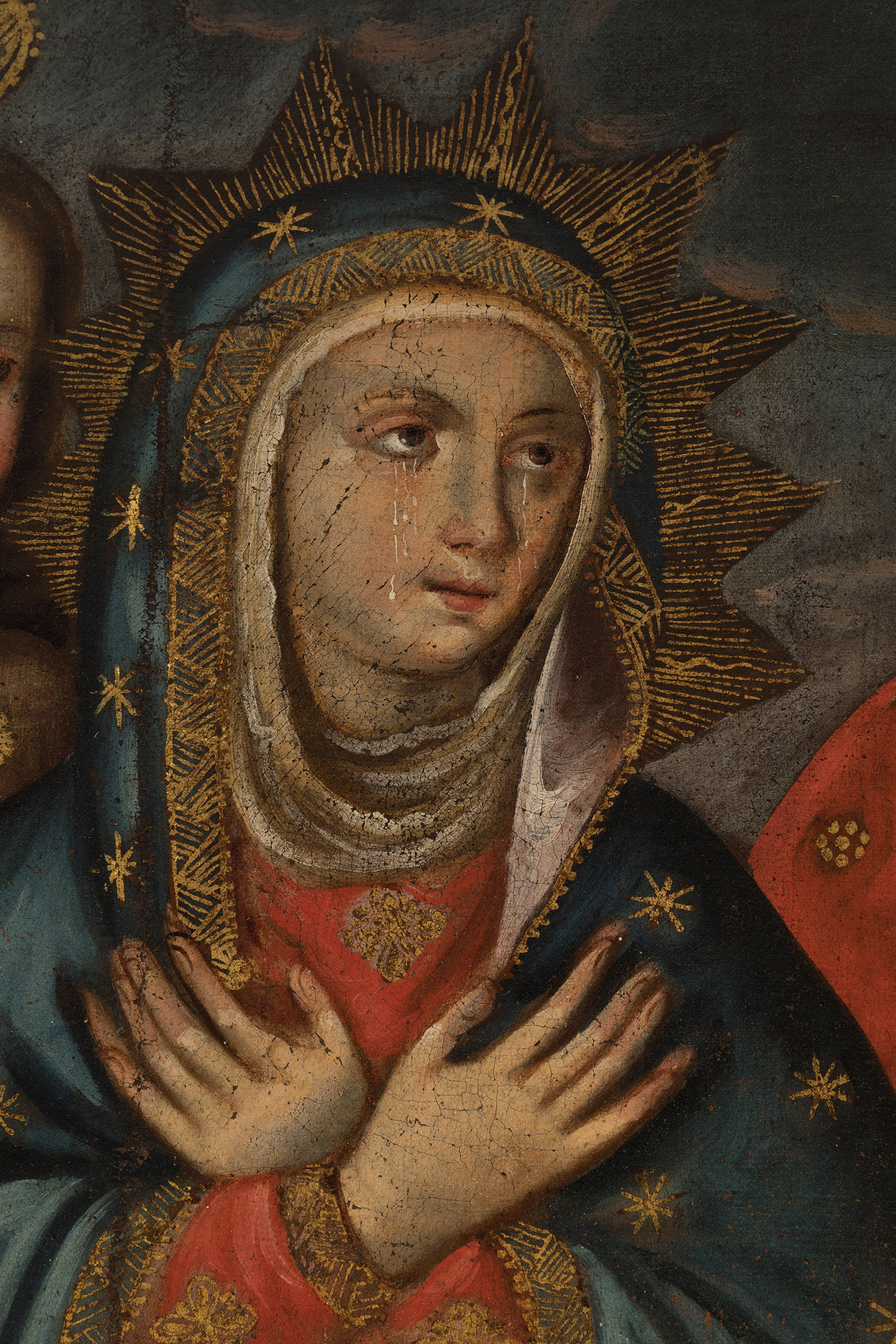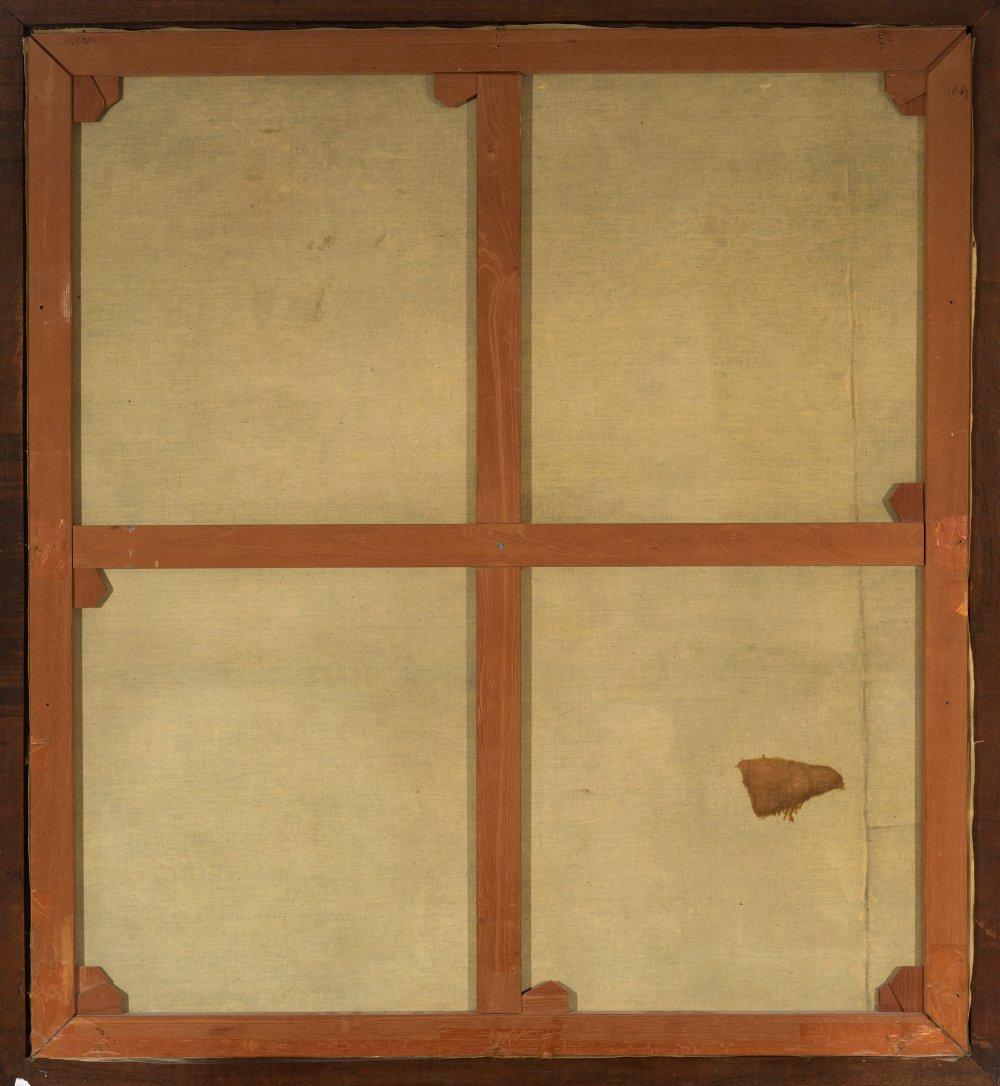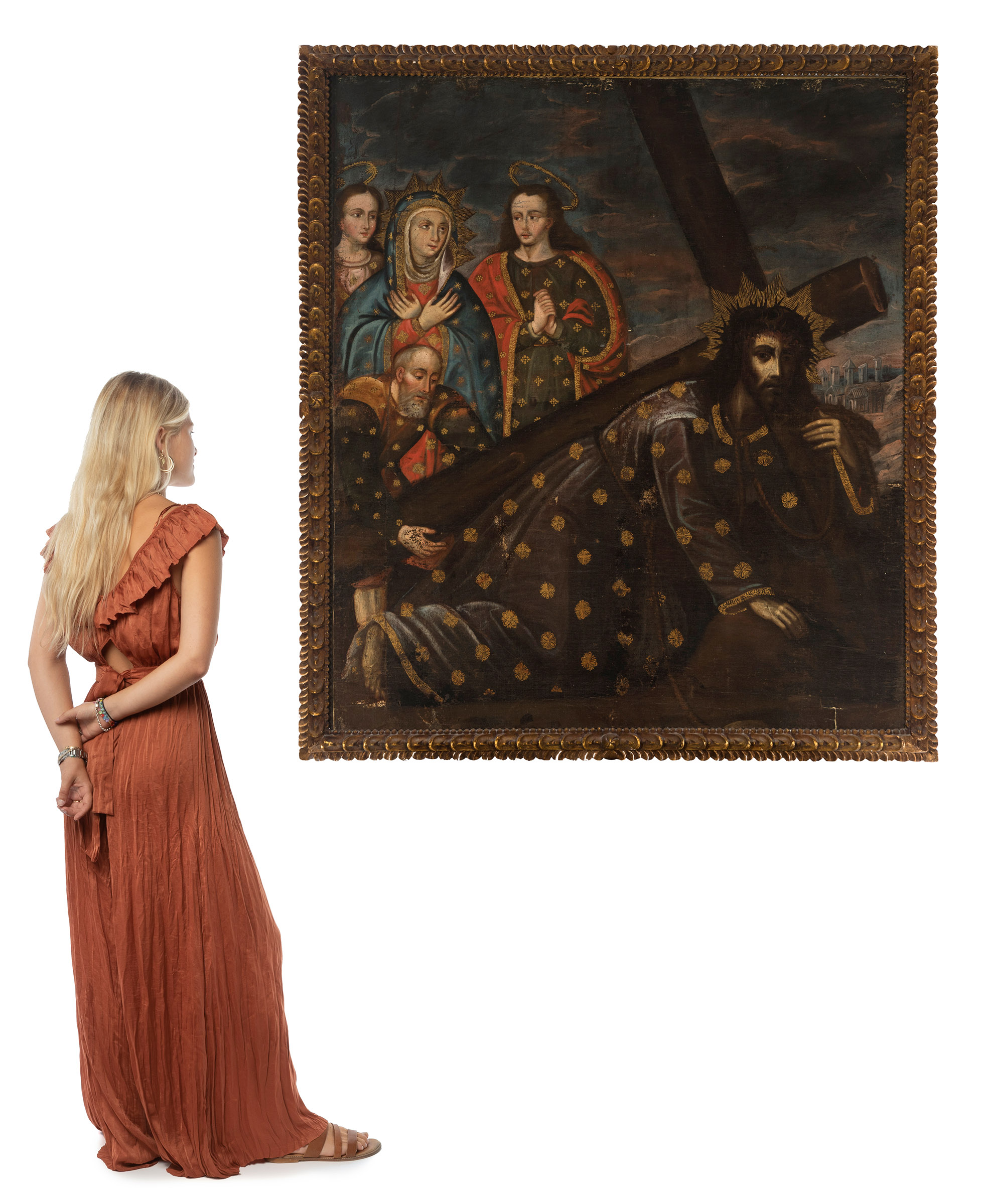12
Quito School; late 17th century."The Fall during Calvary".Oil on canvas. Re-drawn.It presents
"The Fall during Calvary".
Oil on canvas. Re-drawn.
It presents restorations.
Sizes: 139 x 125 cm; 150 x 136 cm (frame).
In this canvas the author captures one of the most dramatic moments of the Way of the Cross, the moment in which Christ bears the weight of the cross. In this episode it is common to see Simon the Cyrenian helping Jesus to carry the cross, or Veronica offering him a cloth to wipe his face clean of blood and sweat. However, the author of this canvas dispenses with these figures and seeks no theological meaning other than that of Christ's own suffering and voluntary sacrifice on behalf of humanity. In fact, this supreme generosity is reinforced by Jesus' own gaze, which is directed towards ours. The monumentality of the figure of Christ defines the whole image, in such a way that other elements such as the other figures or the landscape in the background are relegated to the background. Exhausted by the blood lost in the scourging, weakened by the physical and moral suffering inflicted on him the night before, and without having slept, Jesus could barely take a few steps and soon fell under the weight of the cross. Then followed the blows and imprecations of the soldiers, the expectant laughter of the crowd. The Messiah, with all the strength of his will and with all his might, managed to get up and continue on his way. According to theological interpretations, Jesus invites us by his actions to carry our cross and follow him, he teaches us here that we too can fall, and that we must understand those who fall; that none of us must remain prostrate, we must all get up with humility and trust, seeking his help and forgiveness.
Technically and stylistically, the work is part of the Quito school, one of the most important colonial hotbeds of religious art in the world during the Baroque period. Indigenous and mestizo artists trained in the workshops of the convents of the Ecuadorian capital. In the 17th century, the Quito school of painting began to flourish, represented by four great masters: Hernando de la Cruz, Miguel de Santiago, Isabel de Santiago and Nicolás Javier Goribar, artists who started from a tradition originating in Spain, transgressing the imposed style and contributing an idiosyncratic language to their pictorial work. It is worth mentioning that, during the Spanish colonial domination, a mainly religious painting was developed, aimed at Christianising the indigenous peoples. Local painters were modelled on Spanish works, which they followed literally in terms of type and iconography. The most frequent models were harquebusier angels and triangular virgins; however, in the early years of the 19th century, at the time of independence and political openness in some of the colonies, several artists began to depict a new model of painting with its own identity.
"The Fall during Calvary".
Oil on canvas. Re-drawn.
It presents restorations.
Sizes: 139 x 125 cm; 150 x 136 cm (frame).
In this canvas the author captures one of the most dramatic moments of the Way of the Cross, the moment in which Christ bears the weight of the cross. In this episode it is common to see Simon the Cyrenian helping Jesus to carry the cross, or Veronica offering him a cloth to wipe his face clean of blood and sweat. However, the author of this canvas dispenses with these figures and seeks no theological meaning other than that of Christ's own suffering and voluntary sacrifice on behalf of humanity. In fact, this supreme generosity is reinforced by Jesus' own gaze, which is directed towards ours. The monumentality of the figure of Christ defines the whole image, in such a way that other elements such as the other figures or the landscape in the background are relegated to the background. Exhausted by the blood lost in the scourging, weakened by the physical and moral suffering inflicted on him the night before, and without having slept, Jesus could barely take a few steps and soon fell under the weight of the cross. Then followed the blows and imprecations of the soldiers, the expectant laughter of the crowd. The Messiah, with all the strength of his will and with all his might, managed to get up and continue on his way. According to theological interpretations, Jesus invites us by his actions to carry our cross and follow him, he teaches us here that we too can fall, and that we must understand those who fall; that none of us must remain prostrate, we must all get up with humility and trust, seeking his help and forgiveness.
Technically and stylistically, the work is part of the Quito school, one of the most important colonial hotbeds of religious art in the world during the Baroque period. Indigenous and mestizo artists trained in the workshops of the convents of the Ecuadorian capital. In the 17th century, the Quito school of painting began to flourish, represented by four great masters: Hernando de la Cruz, Miguel de Santiago, Isabel de Santiago and Nicolás Javier Goribar, artists who started from a tradition originating in Spain, transgressing the imposed style and contributing an idiosyncratic language to their pictorial work. It is worth mentioning that, during the Spanish colonial domination, a mainly religious painting was developed, aimed at Christianising the indigenous peoples. Local painters were modelled on Spanish works, which they followed literally in terms of type and iconography. The most frequent models were harquebusier angels and triangular virgins; however, in the early years of the 19th century, at the time of independence and political openness in some of the colonies, several artists began to depict a new model of painting with its own identity.
26th October - Old Masters
Sale Date(s)
Venue Address
General delivery information available from the auctioneer
Setdart offers Worldwide shipping
PICK UP IN ROOM: You can come and pick up your lots in our offices (Barcelona, Madrid or Valencia). At the moment of the withdrawal, you will be able to accept the current conditions of the lot by means of a document that you will sign.
YOU CAN SEND ANOTHER PERSON TO PICK UP: This person must present a signed authorization that you can find in our web page by accessing from BUY AT SETDART- LOGISTICS-DOWNLOAD AUTHORIZATION DOCUMENT. You can also send an e-mail with the requested data in AUTHORIZATION DOCUMENT to admin@setdart.com
Important Information
25% buyer´s premium
21% buyer´s premium at www.setdart.com
Terms & Conditions
The maximum period to pay the lots is 7 working days. You can pay either via bank transfer or with credit card through our platform www.setdart.com (we only accept VISA or Mastercard).
BUYER´S PREMIUM: 22% Hammer price + 21% VAT from the buyer´s premium
If your piece has more than 100 years, our Ministry of Culture requires an export certificate in order for the piece to leave the country. Note that if the piece goes inside the EU, there is no cost for the export certificate. If the piece goes outside the EU, there is a cost for the export certificate. You can find more information in our Ministry of Culture website: https://www.culturaydeporte.gob.es/en/cultura/patrimonio/exportacionimportacion/exportacion/tasas.html
INQUIRIES: admin@setdart.com
Setdart guides you through the entire process, from the time of award to the day you receive your lot. Our logistics team will be happy to manage your transport, and will advise you on the best shipping method with professionals from the sector used to handling works of art and jewelry.
WE OFFER WORLDWIDE DOOR TO DOOR SHIPPING
PICK UP IN ROOM: You can come and pick up your lots in our offices. At the moment of the withdrawal, you will be able to accept the current conditions of the lot by means of a document that you will sign.
YOU CAN SEND ANOTHER PERSON TO PICK UP: This person must present a signed authorization that you can find in our web page by accessing from BUY AT SETDART-LOGISTICS-DOWNLOAD AUTHORIZATION DOCUMENT. You can also send an e-mail with the requested data in AUTHORIZATION DOCUMENT to admin@setdart.com
SETDART IS NOT RESPONSIBLE FOR THE STATE OF THE PARTS ONCE THEY LEAVE OUR FACILITIES. MRW SHIPMENTS: Once the payment is made, your lot will be packed for shipment, the logistics department will send you an e-mail notifying you of the day it leaves our warehouse, changes of address cannot be made after receiving this e-mail.
INSURANCE INCIDENTS: Coverage for the value of the auction up to 3000 ? per shipment, if the value of the auction is higher, Setdart will send you a quote including the additional insurance. The insurance company WILL NOT BE RESPONSIBLE FOR THE SHIPMENT THAT EXCEEDS THAT AMOUNT AND IS NOT FULLY INSURED. MRW INCIDENTS: Maximum notification 48 hours after receipt, after which the insurance company WILL NOT BE RESPONSIBLE AND NO CLAIMS WILL BE ACCEPTED.
E-MAIL LOGISTICS: logistica@setdart.com
PICK UP YOUR MESSAGES: You can send your own messaging, prior notice via e-mail that your shipment is ready, please note 3 or 4 days in advance. This type of shipment is packaged so Setdart will provide you with a quote.
EXPENSES FOR STORAGE: We inform you that if the purchased lot is not picked up within a month, you will be charged 30€ per week per lot. Setdart Online S.L., owner of the web site "setdart.com", "setdart.net" and "setdart.org", acts as a company of Spanish nationality inscribed in the Volume 36955, sheet 182, page B-293056 of the Mercantile Registry, with registered office at Calle Aragó















